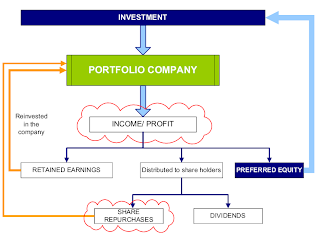- Corporations ----- Main Entity/ Products/ Projects
- Management Consulting ----- Specific expertise/ services
- Investor ----- Investment/ Wealth Management
- NPOs ----- Human resource capacity building/ deep penetration
- Government/ Multi-lateral Institutions ----- Regulatory bodies/ policy
- Information technology ----- Information systems/ MIS
- Banks/ Financial Services ----- Finance
Monday, October 29, 2012
Around corporate systems
Modern Aryan Society
Corporations - Temple systems
Entrepreneurs - Vaishyas
Investors - Temple founding heads/ Yogis
Astrophysicists/ Macro-Economists/Theoretical physicists - Yogis/hermits
Mathematicians - Ascetic/ Sannyasis
Financial experts - Priests
CEOs - Kings/ Ruling class
Management consultants - Brahmins
Finance - Religion
Options - Dakshinas
Private Equity - Patrons of temple systems
Doctors/engineers/IT technicians/applied scientists - Sudras
Corporate office - High temple
Models - Vedas/Upanishads/scriptures
Data - mantras
Government administrators - Kshatriyas/ subordinate ruling class
Informational technology - Thought waves
Computers - Temple library and signal receiving mind of refined yogis
Internet and Database - Temple library
Global/Macro-economics - BRAHMAN/BRAHMA
Applications of science/ scientific method - disciplining method/ YOGA
National universities - Gurukuls/monasteries
Research institutions and laboratories - ashrams
Professors/ teachers - gurus/authors of purans
Microscale traders/workers/labourers - Mlechhas
Center of Cardinal direction/GPS - Mount Kailash
Local celebrities - Gods/goddesses
Sophisticated people/ those pursuing art or cultural activities - Gandharvas
Scientists/Researchers - Rishis/Munis
AC rooms/boardrooms- Garba-griha
Chambers for think-tanks - Himalayan/mountain caves
Sitting posture in arm chair - Yogic/meditative posture
Executive arm chair - Singhasan
Investment returns - Prasads/Ashirbads from head priests
To be continued...........
Wednesday, October 24, 2012
Monday, October 22, 2012
Sunday, October 21, 2012
Saturday, October 20, 2012
Friday, October 19, 2012
Friday, October 12, 2012
Thursday, October 4, 2012
Relations between Climate Change, Sustainability, Kyoto Protocol, Carbon Trading and Funding of Activities of Small and Medium Enterprises
Scientists
found that the temperature of planet earth is rising and that climate is
changing. The cause of the current climate change was attributed to emissions
of green house gases by fossil fuels and low energy efficient technologies.
Kyoto Protocol tried to come up with few instruments and mechanisms to address
the change in climate and to facilitate the development of sustainable low
emission technologies in a market dominated by established high emission, low
energy efficient technologies. At the protocol, developed countries pledged to
reduce their carbon emission to certain levels to address climate change. One
of the instruments that was formulated was carbon trading. This is a cap and
trade system in which a central body fixes the emission limit of different
countries and the member countries are allocated limits or caps to greenhouse
gas emission level. These caps are also allocated to corporations and large
companies. The companies receive or buy the allocation caps from the central
authorities and continue with their operations. If the countries or companies seems
to exceed the allocated emission levels, they have few options like trade the emission
units among themselves (emission trading), invest in low emission sustainable
technologies and projects or cut their present productions and operations. Now,
in order to facilitate the investment in low emission technology, the Kyoto
protocol came up with few mechanisms, two of which are clean development
mechanism (CDM) and landuse, landuse change and forestation (LULUCF). CDM
allows a developed country to invest in sustainable low emission projects in
developing countries and obtain certified emission reduction (CRM) certificates
on successful completion of sustainability projects. These CRM certificates
thus allows developed countries to obtain extra emission units and at the same
time facilitates transfer and growth of low emission technologies in developing
countries. LULUCF also facilitates afforestation and carbon sequestration
projects in developing countries and provides emission reduction certificates
to developed countries and corporations. It is in the position of facilitating
CDM and LULUCF projects and providing emission reduction units that small and
medium sized enterprises say XYZ in
developing countries (INDIA) come into play. These SMEs obtain funding through
intermediaries like venture capitals, capital investment funds etc. to
undertake low emission projects like sustainable energy, technology change etc.
In case of XYZ, there are a number of such projects like biomass briquettes,
change to solar technology from diesel for salt production, marketing and
selling of natural salt, mangrove habitat regeneration, watershed development
etc. These activities belong sustainable development projects and thus receives funding allocated
for emission reduction projects from developed countries and corporations. These
enterprises generally have good connections with the community and ground level
knowledge and thus facilitate sustainable development and technology transfer
in developing countries upon receiving the allocated funding and sustainable investment
funds from the developed countries and corporations. Upon completion of the
sustainable development projects, the enterprises provide the project results
and data like area of land-use change etc. to the corporations and countries
directly or through intermediaries, who thereby convert them and obtain the
emission reduction units.
Subscribe to:
Posts (Atom)






